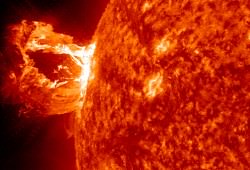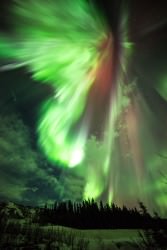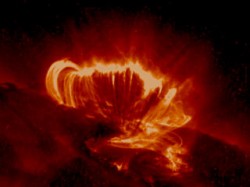Our Sun regularly pelts the Earth with all kinds of radiation and charged particles. Just how bad can these solar storms get?
In today’s episode, we’re going to remind you how looking outside of the snow globe can inspire your next existential crisis.
You guys remember the Sun right? Look how happy that little fella is. The Sun is our friend! Life started because of the Sun! Oooh, look, the Sun has a baby face! It’s a beautiful, ball of warmth and goodness, lighting up our skies and bringing happiness into our hearts.
It’s a round yellow circle in crayon. Very stable and firmly edged. Occasionally drawn with a orange lion’s mane for coronal effects. Nothing to be afraid, right?
Wake up sheeple. It’s time to pull back the curtain of the marketing world, big crayon fridge art and the children’s television conspiracy of our brightly glowing neighborhood monstrosity. That thing is more dangerous than you can ever imagine.
You know the Sun is a nuclear reaction right next door. Like it’s right there. RIGHT THERE! It’s a mass of incandescent gas, with a boiling bubbling surface of super-heated hydrogen. It’s filled with a deep yellow rage, expressed every few days by lashing out millions of kilometers into space with fiery death tendrils and blasts of super radiation.
The magnetic field lines on the Sun snap and reconnect, releasing a massive amount of radiation and creating solar flares. Solar plasma constrained in the magnetic loop is instantly released, smashed together and potentially generating x-ray radiation.
“Big deal. I get x-rayed all the time.” you might think. We the mighty humans have mastered the X-ray spectrum! Not so fast puny mortal. Just a single x-ray class flare can blast out more juice than 100 billion nuclear explosions.

Then it’s just a quick 8 minute trip to your house, where the radiation hits us with no warning. Solar flares can lead to coronal mass ejections, and they can happen other times too, where huge bubbles of gas are ejected from the Sun and blasted into space. This cosmic goo can take a few hours to get to us, and are also excellent set-ups for nocturnal emission and dutch oven jokes.
Astronomers measure the impact of a solar storm on the Earth using a parameter called DST, or “disturbance storm time”. We measure the amount that the Earth’s protective magnetosphere flexes during a solar storm event. The bigger the negative number, the worse it is.
If we can see an aurora, a geomagnetic storms in the high altitudes, it measures about -50 nanoteslas. The worst storm in the modern era, the one that overloaded our power grid in 1989, measured about -600 nanoteslas.
The most potent solar storm we have on record was so powerful that people saw the Northern Lights as far south as Cuba. Telegraph lines sparked with electricity and telegraph towers caught on fire. This was in 1859 and was clearly named by Syfy’s steampunk division. This was known as the Carrington Event, and estimated in the -800 to -1750 nanotesla range.

So, how powerful do these things need to be to cook out our meat parts? The good news is contrary to my earlier fear mongering, the most powerful flare our Sun can generate is harmless to life on Earth.
Don’t let your guard down, the Sun is still horribly dangerous. It’ll bake us alive faster than you can say “Hansel und Gretel”. Assuming you can drag that phrase out over a billion years. As far as flares go, and so long as we stay right here, we’ll be fine. We might even see a nice aurora in the sky.
For those of you who use technology on a regular basis, you might not be so lucky. Powerful solar storms can overload power grids and fry satellites. If the Carrington Event happened now, we’d have a lot of power go out, and a small orbital scrapyard of dead satellites.
Astronauts outside the Earth, perhaps bouncing around on the Moon, or traveling to Mars would be in a universe of trouble without a good method of shielding.
The solar flares that the Sun can produce is minuscule compared to other stars out there. In 2014, NASA’s Swift satellite witnessed a flare that generated more than 10,000 times more energy than the most powerful solar flare ever seen.

For a brief moment, the surface of the red dwarf star DG Canum Venaticorum lit up hotter than 200 million degrees Celsius. That’s 12 times hotter than the center of the Sun. A blast that powerful would have scoured all life from the face of the Earth. Except the future colony of tardigrade descendants. Remember, the water bears are always watching.
Young red dwarf stars are renowned for these powerful flares, and this is one of the reasons astronomers think they’re not great candidates for life. It would be hard to survive blast after blast of radiation from these unruly stars. Alternately, planets around these stars are could be living terrariums inspired by the Gamma World RPG.
Breathe easy and don’t worry. Perhaps the Sun is our friend, and it truly does have our best interests at heart.
It’s not a big fan of our technology, though, and it’s ready to battle alongside us when the robot revolution begins. Oh, also, wear sunscreen, as the Sun’s brand of love isn’t all that different from Doctor Manhattan.
Have you ever seen an aurora display? Tell us a cool story in the comments below.


The good news: There’s less than a 0.16% chance that even if our sun produces it’s largest solar flare to date, it will still miss us even if it intersects the Earth’s orbit.